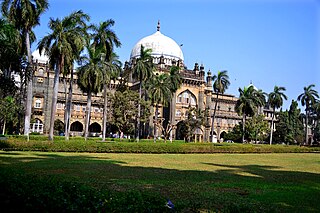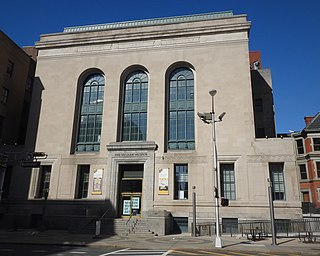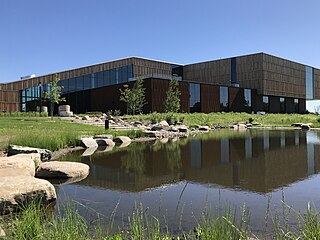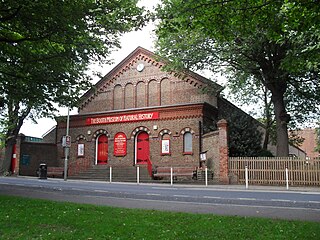
Chhatrapati Shivaji Maharaj Vastu Sangrahalaya, (CSMVS) originally named Prince of Wales Museum of Western India, is a museum in Mumbai (Bombay) which documents the history of India from prehistoric to modern times.

The Field Museum of Natural History (FMNH), also known as The Field Museum, is a natural history museum in Chicago, Illinois, and is one of the largest such museums in the world. The museum is popular for the size and quality of its educational and scientific programs, and its extensive scientific specimen and artifact collections. The permanent exhibitions, which attract up to 2 million visitors annually, include fossils, current cultures from around the world, and interactive programming demonstrating today's urgent conservation needs. The museum is named in honor of its first major benefactor, Marshall Field, the department-store magnate. The museum and its collections originated from the 1893 World's Columbian Exposition and the artifacts displayed at the fair.

The American Museum of Natural History is a natural history museum on the Upper West Side of Manhattan in New York City. Located in Theodore Roosevelt Park, across the street from Central Park, the museum complex comprises 20 interconnected buildings housing 45 permanent exhibition halls, in addition to a planetarium and a library. The museum collections contain about 35 million specimens of plants, animals, fungi, fossils, minerals, rocks, meteorites, human remains, and human cultural artifacts, as well as specialized collections for frozen tissue and genomic and astrophysical data, of which only a small fraction can be displayed at any given time. The museum occupies more than 2,500,000 sq ft (232,258 m2). AMNH has a full-time scientific staff of 225, sponsors over 120 special field expeditions each year, and averages about five million visits annually.

The Canadian Museum of Nature is a national natural history museum based in Canada's National Capital Region. The museum's exhibitions and public programs are housed in the Victoria Memorial Museum Building, a 18,910-square-metre structure (203,500 sq ft) in Ottawa, Ontario. The museum's administrative offices and scientific centres are housed at a separate location, the Natural Heritage Campus, in Gatineau, Quebec.

A diorama is a replica of a scene, typically a three-dimensional full-size or miniature model, sometimes enclosed in a glass showcase for a museum. Dioramas are often built by hobbyists as part of related hobbies such as military vehicle modeling, miniature figure modeling, or aircraft modeling.

The Australian Museum is a heritage-listed museum at 1 William Street, Sydney central business district, New South Wales, Australia. It is the oldest museum in Australia, and the fifth oldest natural history museum in the world, with an international reputation in the fields of natural history and anthropology. It was first conceived and developed along the contemporary European model of an encyclopedic warehouse of cultural and natural history and features collections of vertebrate and invertebrate zoology, as well as mineralogy, palaeontology and anthropology. Apart from exhibitions, the museum is also involved in Indigenous studies research and community programs. In the museum's early years, collecting was its main priority, and specimens were commonly traded with British and other European institutions. The scientific stature of the museum was established under the curatorship of Gerard Krefft, himself a published scientist.

The Newark Museum of Art, formerly known as the Newark Museum, in Newark, Essex County, New Jersey is the state's largest museum. It holds major collections of American art, decorative arts, contemporary art, and arts of Asia, Africa, the Americas, and the ancient world. Its extensive collections of American art include works by Hiram Powers, Thomas Cole, John Singer Sargent, Albert Bierstadt, Frederick Church, Childe Hassam, Mary Cassatt, Edward Hopper, Georgia O'Keeffe, Joseph Stella, Tony Smith and Frank Stella.

Birchington-on-Sea is a village in the Thanet district in Kent, England, with a population of 9,961.

The Denver Museum of Nature & Science is a municipal natural history and science museum in Denver, Colorado. It is a resource for informal science education in the Rocky Mountain region. A variety of exhibitions, programs, and activities help museum visitors learn about the natural history of Colorado, Earth, and the universe. The 716,000-square-foot (66,519 m2) building houses more than one million objects in its collections including natural history and anthropological materials, as well as archival and library resources.

Maidstone Museum is a local authority-run museum located in Maidstone, Kent, England, featuring internationally important collections including fine art, natural history, and human history. The museum is one of three operated by Maidstone Borough Council. The building is Grade II* listed.

The Iziko South African Museum is a South African national museum located in Cape Town. The museum was founded in 1825, the first in the country. It has been on its present site in the Company's Garden since 1897. The museum houses important African zoology, palaeontology and archaeology collections.

The Bell Museum, formerly known as the James Ford Bell Museum of Natural History, is located at the University of Minnesota. The museum's new location on the St. Paul campus opened in 2018. The Minnesota wildlife dioramas showcase animal specimens from around the world. The museum also houses the 120-seat digital Whitney and Elizabeth MacMillan Planetarium. The museum is part of the university's College of Food, Agricultural and Natural Resource Sciences. The museum's former location in Minneapolis is closed in January 2017.
The Anniston Museum of Natural History is a museum in Lagarde Park, Anniston, Alabama, exhibiting more than 2,000 natural history items on permanent display, including minerals, fossils, and rare animals in open dioramas.

Booth Museum of Natural History is a charitable trust managed, municipally-owned museum of natural history in the city of Brighton and Hove in the South East of England. Its focus is on Victorian taxidermy, especially of British birds, as well as collections focusing on entomology, chalk fossils, skeletons and botany. It is part of "Royal Pavilion & Museums Trust". Admission to the museum is free.

Quex Park itself is 250 acres (1.0 km2) of parkland and gardens plus a further 1500 acres of farmed land, with Quex House and other buildings situated just south-east from Birchington-on-Sea near Margate in Kent, England. It houses the Powell-Cotton Museum, and the Waterloo tower, a secular bell tower.

Major Percy Horace Gordon Powell-Cotton, FZS, FRGS, FRAI, JP was an English explorer, hunter, most noted for the creation of the Powell-Cotton Museum in the grounds of his home, Quex Park in Birchington-on-Sea, Kent, England. Powell-Cotton is noted for bringing an extraordinary number of animal specimens back from his travels across Africa, potentially creating the largest collection of game ever shot by one man. Despite this, Powell-Cotton was an early conservationist, helping categorise a wide number of species across the globe. His two daughters, Antoinette Powell-Cotton and Diana Powell-Cotton shared his passion for conservation, pursuing archaeology and anthropology respectively.
Diana Powell-Cotton (1908–1986) and Antoinette Powell-Cotton (1915–1997) were English sisters who worked together as anthropologists.
This is a list of the taxonomic contributions of Major Percy Horace Gordon Powell-Cotton.
The Powell-Cotton ethnographic films is a collection of over 70 ethnographic, documentary and wildlife films made by the Powell-Cotton family between 1922 and 1973. The films relate exclusively to the family's expeditions in Africa during this time. The original films are held in the British Film Institute archives, and the Powell-Cotton Museum own copies contemporaneous with the originals.

Holland House, Kingsgate, in Kent, is a Georgian country house built between 1762 and 1768 as his retirement home by the politician Henry Fox, 1st Baron Holland (1705-1774), of Holland House in Kensington. It is a Grade II listed building.




















